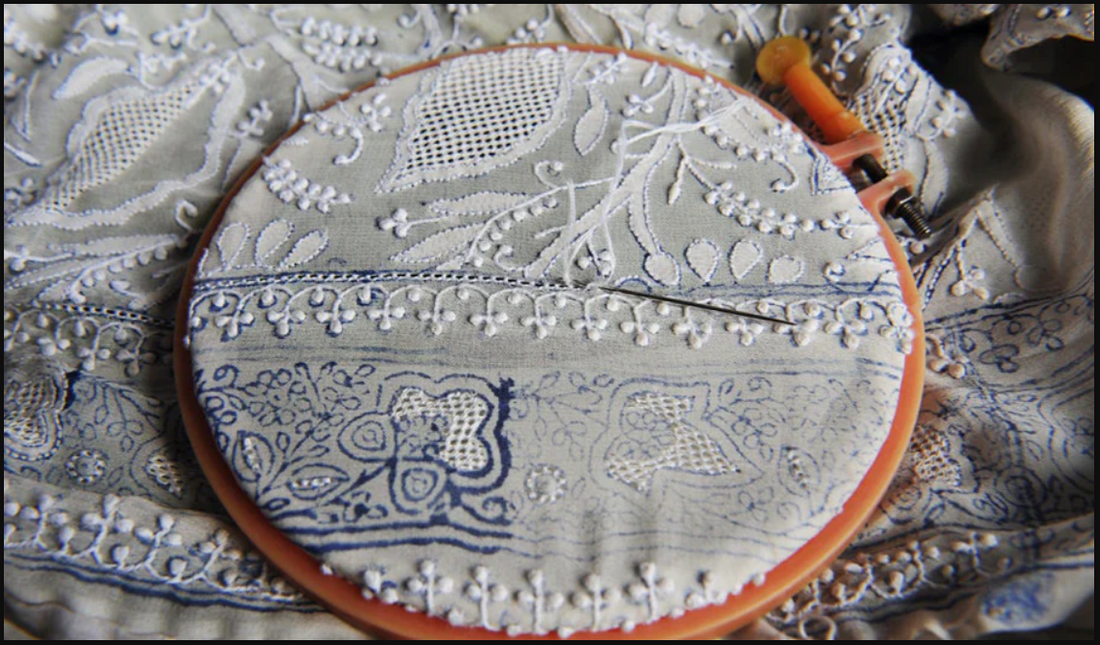
The Art of Chikankari : A Tapestry of Elegance and Skill
Partager
In the realm of traditional Indian handicrafts, Chikankari stands out as a testament to timeless artistry and exquisite craftsmanship. Originating from the heart of Northern India, this delicate form of hand embroidery has been passed down through generations, evolving into a symbol of elegance and cultural heritage. In this blog post, we will explore the enchanting world of Chikankari, delving into the intricate techniques, the laborious efforts invested, and the diverse materials that contribute to the creation of these ethereal masterpieces.
The Art of Chikankari:
Chikankari is a meticulous form of hand embroidery that originated in the city of Lucknow, in the state of Uttar Pradesh, India. Renowned for its delicate and intricate patterns, Chikankari involves the artful manipulation of thread on various fabrics, creating a harmonious blend of texture and design. The word "Chikan" itself is derived from the Persian word "Chikin" or "Chikeen," which means embroidery.
The embroidery is typically done with white thread on pastel-colored fabrics, although contemporary designs may incorporate a broader spectrum of colors. Chikankari is known for its fine stitches, including the backstitch, chain stitch, and hemstitch, each contributing to the creation of delicate motifs such as flowers, paisleys, and vines.
Effort and Expertise:
Creating a piece of Chikankari is no small feat; it requires immense skill, patience, and a deep understanding of the craft. Artisans, often referred to as 'karigars,' spend countless hours meticulously hand-embroidering every inch of fabric. The process involves drawing the design on the fabric, selecting the appropriate stitches, and then executing the embroidery with precision.
The effort intensifies when working on complex patterns, as the artisan must navigate the fabric delicately to maintain consistency and accuracy. The level of expertise required to produce flawless Chikankari is acquired through years of practice and a genuine passion for the art.
Types of Materials:
Chikankari can be executed on a variety of fabrics, with cotton and muslin being the most popular choices. The lightweight and breathable nature of these fabrics make them ideal for the delicate embroidery. Additionally, silk and georgette are also used for more formal and luxurious Chikankari garments.
The threads used in Chikankari are traditionally white, creating a subtle and elegant contrast against the colored fabric. However, contemporary designs have embraced a wider palette of colors, allowing artisans to experiment with different combinations to suit modern tastes.
The Cultural Significance:
Chikankari is not merely a craft; it is a cultural phenomenon deeply rooted in the heritage of Northern India. The art form has been patronized by royalty for centuries, and today, it continues to be an integral part of the region's cultural identity. Chikankari garments, ranging from sarees and suits to accessories, are often worn during special occasions, weddings, and festivals, embodying a sense of tradition and grace.
Conclusion:
Chikankari is more than just embroidery; it is a timeless expression of skill, patience, and cultural richness. As we admire the delicate patterns and intricate stitches, let us not only appreciate the aesthetic beauty but also acknowledge the hands and hearts behind each masterpiece. In a world that often leans towards mass production, Chikankari stands as a testament to the enduring allure of handcrafted artistry.
